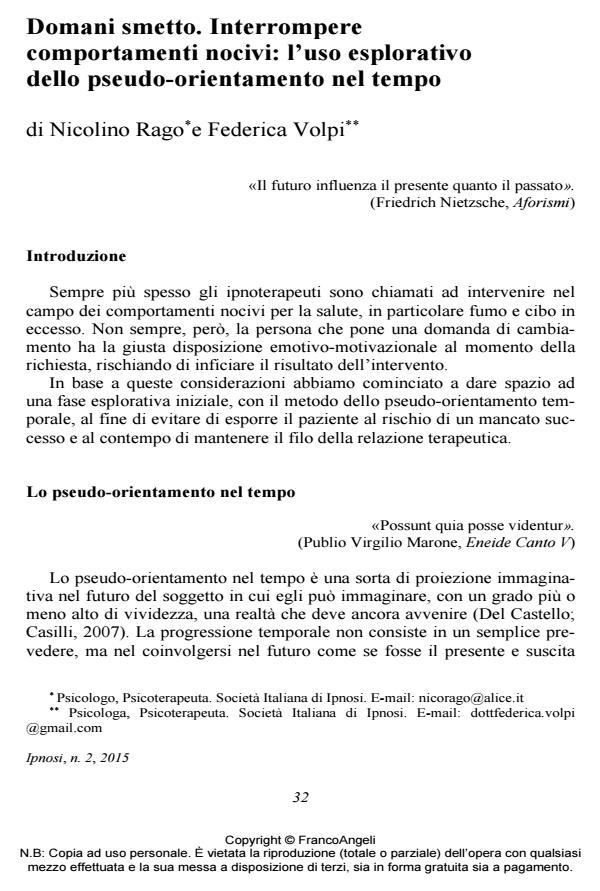Domani smetto. Interrompere comportamenti nocivi: l’uso esplorativo dello pseudo-orientamento nel tempo
Titolo Rivista IPNOSI
Autori/Curatori Nicolino Rago, Federica Volpi
Anno di pubblicazione 2015 Fascicolo 2015/2 Lingua Italiano
Numero pagine 16 P. 32-47 Dimensione file 74 KB
DOI 10.3280/IPN2015-002002
Il DOI è il codice a barre della proprietà intellettuale: per saperne di più
clicca qui
Qui sotto puoi vedere in anteprima la prima pagina di questo articolo.
Se questo articolo ti interessa, lo puoi acquistare (e scaricare in formato pdf) seguendo le facili indicazioni per acquistare il download credit. Acquista Download Credits per scaricare questo Articolo in formato PDF

FrancoAngeli è membro della Publishers International Linking Association, Inc (PILA)associazione indipendente e non profit per facilitare (attraverso i servizi tecnologici implementati da CrossRef.org) l’accesso degli studiosi ai contenuti digitali nelle pubblicazioni professionali e scientifiche
Tomorrow I stop it. Interrupting harmful behaviors: the exploratory use of pseudo-orientation in time. In recent years the pseudo-orientation in time has been mainly used as a therapeutic intervention (for example, arousing images and pleasant scenes in depressed patients) or with the evaluation function of the estate of an intervention. The authors want to reconsider the importance of the exploration of the pseudo-orientation in time, recovering the function of insight, that Erickson had already experienced in the 40’s. The method of the "Bridge of the Future", which it will be presented, seems to increase the success’s predictability of an hypnotic intervention. According to the authors, giving more importance to an initial exploratory phase protects the patient from the consequences of a failure for exposing himself at change interventions too early compared to his emotional-motivational disposition at the time of the request. It also allows the patient to discover the blocker factors, to be helped to accept the valid reasons and/or to engage him in a elaboration process of the emotions resulting from the change, even before working for change.;
Keywords:Ipnosi, pseudo-orientamento nel tempo, fumo, dimagrire, insight, immaginazione
- Lazarus A.A. (1977). In the mind’s eye. New York: Rawson.
- Araoz D.L. (1984). Ipnosi e terapia sessuale. Roma: Astrolabio.
- Deci E., Ryan R. (2008). Facilitating optimal motivation and psychological well-being across life’s domains. Canadian Psychology, 49(1): 14-23. DOI: 10.1037/0708-5591.49.1.14
- Del Castello E., Casilli C. (2007). L’induzione ipnotica. Milano: Franco Angeli.
- Ducci G. (2005). Ipnosi e modificazioni della memoria. Ipnosi. Rivista Italiana di Ipnosi Clinica e Sperimentale, 1: 25-36. DOI: 10.1400/62483
- Dudai Y., Carruthers M. (2005). Memory: some systems in the brain may be better equipped to handle the future than the past. Nature, 434: 567-568. DOI: 10.1038/434567a
- El Haj M., Antoine P., Kapogiannis D. (2015). Similarity between remembering the past and imagining the future in Alzheimer’s disease: implication of episodic memory. Neuropsychologia, 66: 119-25. DOI: 10.1016/j.neuropsychologia.2014.11.015
- Erickson M.H. (1984). Opere. Volume IV. Roma: Astrolabio.
- Gray R.M. (2011). Pseudo-orientation in time. Acuity (Online), 2(1): 12-26. Janet P. (1898). Névrosis et idées fixes. Paris: Libraire Felix Alcan.
- Hulleman C.S., Durik A.M., Schweigert S.A., Harackiewicz J.M. (2008). Task values, achievement goals, and interest: an integrative analysis. Journal of Educational Psychology, 100(2): 398-416. DOI: 10.1037/0022-0663.100.2.398
- Koestner R. (2008). Reaching one’s personal goals: a motivational perspective focused on autonomy. Canadian Psychology, 49(1): 60-67. DOI: 10.1037/0708-5591.49.1.60
- Madore K.P., Schacter D.L. (.2014). An episodic specificity induction enhances means-end problem solving in young and older adults. Psychology and Aging, 29(4): 913-24. DOI: 10.1037/a0038209
- Miloyan B., Pachana N.A., Suddendorf T. (2014). The future is here: a review of foresight systems in anxiety and depression. Cognition & Emotion, 28(5): 795-810. DOI: 10.1080/02699931.2013.863179
- Nietzsche F. (2008). Aforismi. Siena: Barbera.
- Rusconi E., Mitchener-Nissen T. (2014). The role of expectations, hype and ethics in neuroimaging and neuromodulation futures. Frontiers in Systems Neuroscience, 8: 214-223. DOI: 10.3389/fnsys.2014.00214.
- Short D.,Casula C. (2004). Speranza e resilienza. Cinque strategie psicoterapeutiche di Milton H. Erickson. Milano: Franco Angeli
- Sools A.M., Tromp T., Mooren J.H. (2015). Mapping letters from the future: exploring narrative processes of imagining the future. Journal Health Psychology, 20(3): 350-364. DOI: 10.1177/1359105314566607
- Suddendorf T., Corballis M. (2007). The evolution of foresight: What is mental time travel, and is it unique to humans? Behavioral and Brain Sciences, 30: 299-313. DOI: 10.1017/S0140525X07001975
- Thorem M.S. (2006). Treating depression: a remedy from the future. In Yapko M.D., a cura di Hypnosis and treating depression: applications in clinical practice. New York: Routledge.
- Tulving E. (2005). Episodic memory and autonoesis: Uniquely human? In Terrace H.S., Metcalfe J., a cura di, The Missing Link in Cognition. NewYork: Oxford University Press.
- Van Boven L., Ashworth L. (2007). Looking Forward, Looking Back: anticipation is more evocative than retrospection. Journal of Experimental Psychology, 136(2): 289-300. DOI: 10.1037/0096-3445.136.2.289
- Virgilio (2001). Eneide. Venezia: Marsilio.
- Vogt O. (1898). Die fraktionierte methode. Zeitschrift f. Hypnotismus, 7: 79-93.
- Watzlawick P. (1985). Hypnotherapy without trance. In Zeig J., a cura di, Ericksonian psycotherapy Vol. 1: Structures. New York: Brummer/Mazel.
- Weilbacher R., Bosisio C. (2010). Smettere di fumare con l’ipnosi. Milano: Franco Angeli.
- Widmann C. (2004). Le terapie immaginative. Roma: Magi.
- Yapko M.D. (1992). Hypnosis and the treatment of depressions: strategies for change. New York: Brummer/Mazel.
- Yapko M.D. (2011). Lavorare con l’ipnosi. Milano: Franco Angeli.
- Crisi di identità e pratiche ipnotiche: miti e caratteristiche della realizzazione di sé Luca Bidogia, in IPNOSI 2/2023 pp.37
DOI: 10.3280/IPN2022-002003
Nicolino Rago, Federica Volpi, Domani smetto. Interrompere comportamenti nocivi: l’uso esplorativo dello pseudo-orientamento nel tempo in "IPNOSI" 2/2015, pp 32-47, DOI: 10.3280/IPN2015-002002